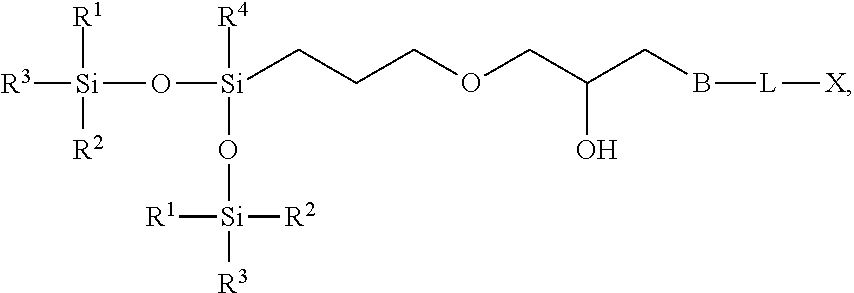Organosiloxane compounds as active ingredients in fluorine free fire suppression foams
a technology active ingredients, which is applied in the field of organic sulfonate foam, can solve the problems of long half-life of perfluorochemical foam in the environment, restricted use, and complete ban of foam containing perfluorochemicals, and achieve the effect of promoting the spread and stabilization of firefighting foam
- Summary
- Abstract
- Description
- Claims
- Application Information
AI Technical Summary
Benefits of technology
Problems solved by technology
Method used
Image
Examples
example 1
of a Silicon Compound According to Structure S1
[0081]The organosiloxane compound of structure S1 was synthesized according to reaction 1. To a 250 ml round bottom flask was added (3-glycidoxypropyl)-bis-(trimethylsiloxy)methylsilane, sodium 2-(methylamino)ethane-1-sulfonate, IPA, and water, where the IPA and water were added in a 2 to 1 ratio. The reaction mixture stirred at 60-65° C. for one day in a closed system followed by the evaporation to remove iso-propanol to give ˜98 (wt) % concentrate as final desired product.
Reaction 1:
[0082]
example 2
of a Silicon Compound According to Structure S2
[0083]The organosiloxane compound of structure S2 was synthesized according to reaction 2. To a 250 ml round bottom flask was added 8.60 g (0.025 mol) of (3-glycidoxypropyl)-bis-(trimethylsiloxy)methylsilane, 5.15 g (0.026 mol) of sodium 3-mercapto-1-propanesulfonate (90% purity), 60 ml of IPA, and 20 ml of water. 0.02 g of NaOH was added to the above mixture to adjust its pH to 7˜8. The mixture was refluxed for 2 days in a closed system followed by the removal of all volatile materials to its constant weight. 12.38 g of white solid was obtained as a final product with a material balance at 96.34 (wt) %.
Reaction 2:
[0084]
example 3
of a Silicon Compound According to Structure S3
[0085]The organosiloxane compound of structure S3 was synthesized according to reaction 3. To a 250 ml round bottom flask was added (3-glycidoxypropyl)-bis-(trimethylsiloxy)methylsilane, sodium 3-mercaptopropionate, IPA and water, where the IPA and water were added in a 3 to 1 ratio. The mixture was then adjusted to a pH of 7˜8. The mixture was refluxed in a closed system for two days followed by the removal of all volatile materials to its constant weight.
Reaction 3:
[0086]
PUM
| Property | Measurement | Unit |
|---|---|---|
| Fraction | aaaaa | aaaaa |
| Fraction | aaaaa | aaaaa |
| Fraction | aaaaa | aaaaa |
Abstract
Description
Claims
Application Information
 Login to View More
Login to View More - R&D
- Intellectual Property
- Life Sciences
- Materials
- Tech Scout
- Unparalleled Data Quality
- Higher Quality Content
- 60% Fewer Hallucinations
Browse by: Latest US Patents, China's latest patents, Technical Efficacy Thesaurus, Application Domain, Technology Topic, Popular Technical Reports.
© 2025 PatSnap. All rights reserved.Legal|Privacy policy|Modern Slavery Act Transparency Statement|Sitemap|About US| Contact US: help@patsnap.com



